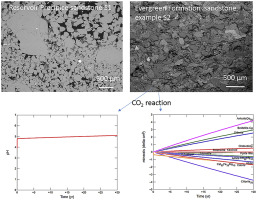当前位置:
X-MOL 学术
›
Appl. Geochem.
›
论文详情
Our official English website, www.x-mol.net, welcomes your feedback! (Note: you will need to create a separate account there.)
Long term reactivity of CO2 in a low salinity reservoir-seal complex
Applied Geochemistry ( IF 3.4 ) Pub Date : 2020-03-01 , DOI: 10.1016/j.apgeochem.2020.104529 J.K. Pearce , A.D. La Croix , J.R. Underschultz , S.D. Golding
Applied Geochemistry ( IF 3.4 ) Pub Date : 2020-03-01 , DOI: 10.1016/j.apgeochem.2020.104529 J.K. Pearce , A.D. La Croix , J.R. Underschultz , S.D. Golding

|
Abstract An understanding of the long-term reactivity of different rock types to injected CO2 is needed for sequestration site assessment. Relative to saline aquifer studies, the long term reactivity of CO2 in low salinity aquifers has received little attention. Currently in Australia, the Surat Basin is being appraised for its large-scale CO2 storage potential within low salinity aquifers. Sixteen core samples from the Precipice Sandstone and Evergreen Formation – the notional target reservoir and seal complex – were characterized for mineral content; helium, mercury-injection and micro CT porosities; air permeability; and, imaged with SEM-EDS. Samples consisted of quartz rich reservoir sandstones, feldspar and clay rich or calcite cemented sandstones (secondary reservoir), mudstones (sealing complex), and oolitic ironstones (sealing complex) derived from braided river, fluvial-deltaic, and restricted marine shoal depositional environments, respectively. The reservoir sandstone samples characterized here had measured total porosity that ranged from 11 to 23% with pore throats mainly between 90 and 100 μm, and core air permeability from 558 to 3397 mD. In the Precipice Sandstone reservoir sample μCT plugs, 98% of the pore space was connected with calculated vertical permeability 145–4611 mD and horizontal 4291–8200 mD. Feldspar and clay rich sandstone and mudstone samples from the overlying Evergreen Formation had porosity that ranged between 0.2 and 22.9%, with a wide range of pore throat sizes from ~0.005 to 30 μm, and permeability from 0.2 to 28.1 mD, respectively. Ironstone and mudstone samples from the Westgrove Ironstone Member (Evergreen Formation) had porosity from 0.7 to 9.7% and a low permeability of 0.04 mD. Kinetic geochemical CO2 reactivity models made predictions over two time-scales: 30 or 1000 years. Selected models also accounted for the potential presence of 10 ppm SO2 gas. The Precipice Sandstone quartz-rich reservoir sandstones had consistently small amounts of reactive minerals and mineral trapping or scaling of the reservoir was not predicted over 30 years, with the pH approximately 4.5 after 30 years. Samples from the Evergreen Formation included feldspar and clay rich sandstones and mudstones, several contained variable amounts of carbonate cement. Their response to CO2 was more influenced by mineral content than rock type. Plagioclase feldspars and Fe-rich chlorite were the main silicate minerals that reacted to produce siderite and ankerite mineral trapping up to 2.57 kg/m3 CO2. In the very unlikely event that CO2 rich fluids migrated upwards as far as the Westgrove Ironstone Member, chlorite is predicted to alter to siderite. This study indicates that the Precipice Sandstone reservoir in the study region has a low likelihood of mineral scaling which is favorable to avoid CO2 injectivity issues. Mineral trapping as ankerite and siderite could be expected to trap CO2 in the chlorite and plagioclase rich Evergreen Formation seal lithologies. Further work is suggested on validating long term predictions with observation data from natural analogue studies.
中文翻译:

CO2 在低盐度储层-密封复合体中的长期反应性
摘要 封存场地评估需要了解不同岩石类型对注入的 CO2 的长期反应性。相对于含盐含水层的研究,低盐度含水层中 CO2 的长期反应性很少受到关注。目前在澳大利亚,苏拉特盆地因其在低盐度含水层中的大规模二氧化碳封存潜力而受到评估。来自悬崖砂岩和常绿地层(名义上的目标储层和密封复合体)的 16 个岩心样品的矿物含量进行了表征;氦气、汞注射和微 CT 孔隙度;透气性; 并且,用 SEM-EDS 成像。样品由富含石英的储层砂岩、富含长石和粘土或方解石胶结砂岩(次生储层)、泥岩(封闭复合体)、和鲕粒铁岩(密封复合体)分别来自辫状河、河流三角洲和受限海相浅滩沉积环境。此处表征的储层砂岩样品测得的总孔隙度为 11% 至 23%,孔隙喉道主要在 90 至 100 μm 之间,岩心透气率从 558 至 3397 mD。在悬崖砂岩储层样品 μCT 塞中,98% 的孔隙空间与计算的垂直渗透率 145-4611 mD 和水平渗透率 4291-8200 mD 相连。来自上覆常绿组的富含长石和粘土的砂岩和泥岩样品的孔隙度介于 0.2% 和 22.9% 之间,孔喉尺寸范围广泛,分别为~0.005 至 30 μm,渗透率分别为 0.2 至 28.1 mD。来自 Westgrove Ironstone 段(Evergreen Formation)的铁岩和泥岩样品具有 0.7% 至 9.7% 的孔隙度和 0.04 mD 的低渗透率。动力学地球化学 CO2 反应性模型在两个时间尺度上进行了预测:30 年或 1000 年。选定的模型还考虑了 10 ppm SO2 气体的潜在存在。悬崖砂岩富含石英的储层砂岩始终含有少量的活性矿物,并且在 30 年内没有预测到储层的矿物捕集或结垢,30 年后 pH 值约为 4.5。来自 Evergreen 地层的样品包括富含长石和粘土的砂岩和泥岩,其中一些含有不同数量的碳酸盐胶结物。他们对二氧化碳的反应更多地受矿物含量的影响而不是岩石类型。斜长石长石和富含铁的绿泥石是主要的硅酸盐矿物,它们发生反应生成菱铁矿和铁橄榄石矿物,捕获量高达 2.57 kg/m3 CO2。在极不可能发生的情况下,富含 CO2 的流体向上迁移到 Westgrove Ironstone 成员,预计绿泥石会变成菱铁矿。该研究表明,研究区域内的悬崖砂岩储层发生矿物结垢的可能性较低,这有利于避免 CO2 注入问题。矿物捕集为铁橄榄石和菱铁矿,有望将 CO2 捕集在富含绿泥石和斜长石的常绿地层封闭岩性中。建议进一步开展工作,用来自自然类似物研究的观察数据验证长期预测。在极不可能发生的情况下,富含 CO2 的流体向上迁移到 Westgrove Ironstone 成员,预计绿泥石会变成菱铁矿。该研究表明,研究区域内的悬崖砂岩储层发生矿物结垢的可能性较低,这有利于避免 CO2 注入问题。矿物捕集为铁橄榄石和菱铁矿,有望将 CO2 捕集在富含绿泥石和斜长石的常绿地层封闭岩性中。建议进一步开展工作,用来自自然类似物研究的观察数据验证长期预测。在极不可能发生的情况下,富含 CO2 的流体向上迁移至 Westgrove Ironstone 成员,预计绿泥石会转变为菱铁矿。该研究表明,研究区域内的悬崖砂岩储层发生矿物结垢的可能性较低,这有利于避免 CO2 注入问题。矿物捕集为铁橄榄石和菱铁矿,有望将 CO2 捕集在富含绿泥石和斜长石的常绿地层封闭岩性中。建议进一步开展工作,用来自自然类似物研究的观察数据验证长期预测。该研究表明,研究区域内的悬崖砂岩储层发生矿物结垢的可能性较低,这有利于避免 CO2 注入问题。矿物捕集为铁橄榄石和菱铁矿,有望将 CO2 捕集在富含绿泥石和斜长石的常绿地层封闭岩性中。建议进一步开展工作,用来自自然类似物研究的观察数据验证长期预测。该研究表明,研究区域内的悬崖砂岩储层发生矿物结垢的可能性较低,这有利于避免 CO2 注入问题。矿物捕集为铁橄榄石和菱铁矿,有望将 CO2 捕集在富含绿泥石和斜长石的常绿地层封闭岩性中。建议进一步开展工作,用来自自然类似物研究的观察数据验证长期预测。
更新日期:2020-03-01
中文翻译:

CO2 在低盐度储层-密封复合体中的长期反应性
摘要 封存场地评估需要了解不同岩石类型对注入的 CO2 的长期反应性。相对于含盐含水层的研究,低盐度含水层中 CO2 的长期反应性很少受到关注。目前在澳大利亚,苏拉特盆地因其在低盐度含水层中的大规模二氧化碳封存潜力而受到评估。来自悬崖砂岩和常绿地层(名义上的目标储层和密封复合体)的 16 个岩心样品的矿物含量进行了表征;氦气、汞注射和微 CT 孔隙度;透气性; 并且,用 SEM-EDS 成像。样品由富含石英的储层砂岩、富含长石和粘土或方解石胶结砂岩(次生储层)、泥岩(封闭复合体)、和鲕粒铁岩(密封复合体)分别来自辫状河、河流三角洲和受限海相浅滩沉积环境。此处表征的储层砂岩样品测得的总孔隙度为 11% 至 23%,孔隙喉道主要在 90 至 100 μm 之间,岩心透气率从 558 至 3397 mD。在悬崖砂岩储层样品 μCT 塞中,98% 的孔隙空间与计算的垂直渗透率 145-4611 mD 和水平渗透率 4291-8200 mD 相连。来自上覆常绿组的富含长石和粘土的砂岩和泥岩样品的孔隙度介于 0.2% 和 22.9% 之间,孔喉尺寸范围广泛,分别为~0.005 至 30 μm,渗透率分别为 0.2 至 28.1 mD。来自 Westgrove Ironstone 段(Evergreen Formation)的铁岩和泥岩样品具有 0.7% 至 9.7% 的孔隙度和 0.04 mD 的低渗透率。动力学地球化学 CO2 反应性模型在两个时间尺度上进行了预测:30 年或 1000 年。选定的模型还考虑了 10 ppm SO2 气体的潜在存在。悬崖砂岩富含石英的储层砂岩始终含有少量的活性矿物,并且在 30 年内没有预测到储层的矿物捕集或结垢,30 年后 pH 值约为 4.5。来自 Evergreen 地层的样品包括富含长石和粘土的砂岩和泥岩,其中一些含有不同数量的碳酸盐胶结物。他们对二氧化碳的反应更多地受矿物含量的影响而不是岩石类型。斜长石长石和富含铁的绿泥石是主要的硅酸盐矿物,它们发生反应生成菱铁矿和铁橄榄石矿物,捕获量高达 2.57 kg/m3 CO2。在极不可能发生的情况下,富含 CO2 的流体向上迁移到 Westgrove Ironstone 成员,预计绿泥石会变成菱铁矿。该研究表明,研究区域内的悬崖砂岩储层发生矿物结垢的可能性较低,这有利于避免 CO2 注入问题。矿物捕集为铁橄榄石和菱铁矿,有望将 CO2 捕集在富含绿泥石和斜长石的常绿地层封闭岩性中。建议进一步开展工作,用来自自然类似物研究的观察数据验证长期预测。在极不可能发生的情况下,富含 CO2 的流体向上迁移到 Westgrove Ironstone 成员,预计绿泥石会变成菱铁矿。该研究表明,研究区域内的悬崖砂岩储层发生矿物结垢的可能性较低,这有利于避免 CO2 注入问题。矿物捕集为铁橄榄石和菱铁矿,有望将 CO2 捕集在富含绿泥石和斜长石的常绿地层封闭岩性中。建议进一步开展工作,用来自自然类似物研究的观察数据验证长期预测。在极不可能发生的情况下,富含 CO2 的流体向上迁移至 Westgrove Ironstone 成员,预计绿泥石会转变为菱铁矿。该研究表明,研究区域内的悬崖砂岩储层发生矿物结垢的可能性较低,这有利于避免 CO2 注入问题。矿物捕集为铁橄榄石和菱铁矿,有望将 CO2 捕集在富含绿泥石和斜长石的常绿地层封闭岩性中。建议进一步开展工作,用来自自然类似物研究的观察数据验证长期预测。该研究表明,研究区域内的悬崖砂岩储层发生矿物结垢的可能性较低,这有利于避免 CO2 注入问题。矿物捕集为铁橄榄石和菱铁矿,有望将 CO2 捕集在富含绿泥石和斜长石的常绿地层封闭岩性中。建议进一步开展工作,用来自自然类似物研究的观察数据验证长期预测。该研究表明,研究区域内的悬崖砂岩储层发生矿物结垢的可能性较低,这有利于避免 CO2 注入问题。矿物捕集为铁橄榄石和菱铁矿,有望将 CO2 捕集在富含绿泥石和斜长石的常绿地层封闭岩性中。建议进一步开展工作,用来自自然类似物研究的观察数据验证长期预测。



























 京公网安备 11010802027423号
京公网安备 11010802027423号